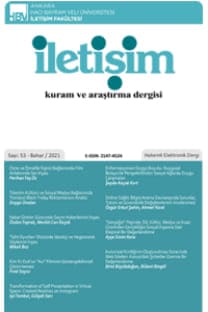Endüstriyel Futbol Çağında "Taraftarlık"
Bu makale, futbol alanında özellikle piyasalaşma temelinde belirlenen değişim süreçlerini genel olarak değerlendirme ve bu süreçlerle birlikte tartışılabileceği düşünülen ‘taraftarlık’ kavramının incelenmesi üzerine kurulmuştur. Makalede ‘taraftarlık’ kavramının görece daha pasif bir anlam içeren ‘seyircilikten’ ayrışması ve bu durumun ‘endüstriyel futbol’ çağında yarattığı düşünülebilecek gerilim üzerinde durulmaya çalışılmıştır. Bu çerçevede uluslararası ve ulusal düzeylerde kimi örnekler verilmeye çalışılmış ve bu örnekler özellikle eleştirel sosyal bilim geleneği çerçevesinde tartışılmaya çalışılmıştır.
'To Be Supporter' In the Industrial Football Age
This article is based on a general consideration of football, particularly the processes of change determined on the ground of marketization, and the analysis of the concept “supporter”, which can be thought as a discussion topic accompanying these processes. In this study, considerable effort is put into the distinction between the “supporter” and the “audience/onlooker”, which has a relatively passive meaning and the tension that can be seen as stemming from this distinction in the age of “industrial football”. In this perspective, the main effort is to give examples in both national and international levels and to discuss these examples from the perspective of critical social sciences literature.
___
- A.S. Roma Ultras manifesto : http://www.asromaultras.it/manifesto.html. (Erişim: 18 Nisan 2008)
- Akşar, T. (2005). Endüstriyel futbol. İstanbul: Literatür.
- Arık, M.B. (2004). Top ekranda. İstanbul: Salyangoz.
- Authier, C. ( 2002). Futbol A.Ş. İstanbul: Kitap.
- Bjelajac, S. (2005, 11-15 Jul). The social structure of football fans in the city of split. Presentation at the 8th international seminar democracy and human rights in multiethnic societies. Konjic-Bosna-Herzegovina.
- Boniface, P. (2007). Futbol ve küreselleşme. İstanbul : NTV.
- Conn, D. (1999). The new commercialism. İçinde: S. Hamil, J. Michie , C. Oughton (der.). A game of two halves? The business of football. London: Mainstream.
- Çevik, E. (2004). Ankaragücü taraftarından bir kesit. İçinde: Bora, T. (der.). Takımdan ayrı düz koşu. İstanbul: İletişim.
- Debord, G. (1996). Gösteri toplumu ve yorumlar. İstanbul: Ayrıntı.
- De Certau (1988). The practice of everyday life. London: University of California.
- Elias, N. & Dunning E. (1986). Quest for excitement: Sport and leisure in the civilising process. London : Blackwell.
- Fiske, John (1999). Popüler kültürü anlamak. Ankara: Ark.
- FSI (2008). Congress invitation. http://footballsupportersinternational.com/en/ (Erişim: 8 Mayıs 2008).
- Girtler, R. (2005).Terbiyesizliğin teorisi, İstanbul :Kale.
- Guilianotti, R. (2005). Towards a critical antropology of voice: the politics and poets of popular culture, scotland and football. Crituque of Antropology, Vol. 25,Is.4:339-359.
- Habermas, J. (1987). The theory of communicative action. Vol 2, Lifeworld and system: a critiqe of functionalist theory. Boston-New York: Beacon.
- Hall, S. (1999). Popüler kültür ve devlet. İçinde: N. Güngör (der.). Popüler kültür ve iktidar. Ankara: Vadi.
- Hatıpoğlu D. & Aydın, B. (2007). Bastır Ankaragücü: Kent, kimlik, endüstriyel futbol ve taraftarlık. Ankara: Epos.
- Howard, S. & Sayce, R. (2002). Branding, sponsorship and commerce in football, Fact Sheet 11, University of Leicister. http:// standupsitdown.co.uk. (Erişim: 18 Nisan 2008).
- Il Movimento del Ultras (2007). Manifesto Ultras, www.movimentoultras.it/doc/ manifesto_ultras.pdf , (Erişim: 18 Nisan 2008).
- King, A. (1997). New directors, customers and fans: The transformation of english football in 1990’s. Sociology of Sport, Vol: 14/3, 226-244.
- King, A. (1998). The end of the terraces: the transformation of english football in 1990’s. London: Leicister University.
- King, A. (2001). Violent pasts: collective memory and football hooliganism. The Sociological Review, Vol 49, N. 4: 568-585.
- Kozanoğlu, C. (2002). Bu maçı alıcaz!, İstanbul: İletişim.
- Lefebvre, H. (1998). Modern dünyada gündelik hayat. İstanbul: Metis.
- Marchi, V. (1994). Ultra: Le sottoculture giovanili negli stadi d’europa. Roma: Koine.
- Marsh P., & Fox K., & Carnibella G., & Mc Cann J., & Marsh J. (1996). Football violence and hooliganism in europe. The Amsterdam Group (www.sirc.org/publik/footballl_violence.ht ml).(Erişim: 1 Mart 2007).
- McGill, C. (2006) Futbolun kârhanesi. İstanbul: İthaki.
- Morris, D. (1981) The soccer tribe. London: J. Cape.
- Negt, O. & Kluge, A. (1993). Public sphere and experience: Toward an analysis of the bourgeois and proletarian public sphere. London: University of Minnesota.
- Oppenhuisen, J. & Zoonen, L.V.(2006).Supporters or consumers? Fandom, marketing and the political economy of Dutch football. Soccer and Society. Vol. 7, No: 1, 62–75.
- Stemmler, Theo (2000). Futbolun kısa tarihi. Ankara: Dost.
- Şahin, M. (2003). Sporda şiddet ve saldırganlık. Ankara: Nobel.
- Talimciler, A. (2003). Türkiye’de futbol fanatizmi ve medya ilişkisi. İstanbul:Bağlam.
- Taylor, I. (1975). Soccer consciosness and soccer hooliganism. İçinde: Cohen S.(der.). Images of deviance. Middlesex: Penguin.
- Thompson, E.P. (1991). Customs In common. London: Penguin.
- Toklucu, M. (2001). Taraftarın senle. İstanbul: İletişim.
- Ünsal, Artun (2005). Tribün cemaatinin öfkesi: Ticarileşen Türkiye futbolunda şiddet.İstanbul: İletişim.
- Walvin, J. (1994). The people’s game the history of football revisited. London: Mains.
- Yayın Aralığı: Yılda 4 Sayı
- Başlangıç: 1983
- Yayıncı: Ankara Hacı Bayram Veli Üniversitesi İletişim Fakültesi
Sayıdaki Diğer Makaleler
Kapitalist Bir Etkinlik Olarak Futbolun Büyüsü ve Kahramanları
1994 Terör Ortamında Vanspor'un Fenerbahçe Yengisinin Siyasallaştırılması
Endüstriyel Futbol Çağında "Taraftarlık"
Çağdaş CEYHAN, Duygu HATİPOĞLU, M. Berkay AYDIN
Türk Basınında İlk Spor Gazetesi "Futbol"
Futbolun Televizyonda Yeniden Üretimi
Mustafa ŞEKER, Abdülkadir GÖLCÜ
Futbol ve Futbolu İnceleme Üzerine
Futbolda Görsel Kimlik Öğesi Olarak Kulüp Armaları
Kapitalist Üretim Sürecinde Irkçılık, Futbol ve Medya
